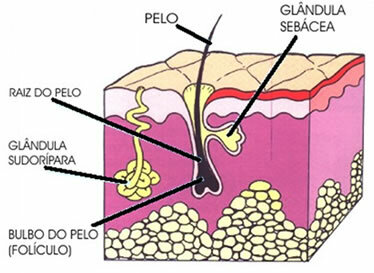O sweat is a liquid produced by sweat glands which are located in the dermis. In our body there are about two million sweat glands distributed in all regions except the nipples, lips and genitals, most of which are located on the face, palms and soles of the foot. The sweat gland has a coiled part where sweat is produced and a long duct connects the sweat gland to the opening or pore on the surface of the skin. The nerve cells of the sympathetic nervous system connect to the sweat glands, which are classified as: eccrine glands and apocrine glands.

Image showing the layer of skin where the sweat glands are located.
At eccrine glands they are found all over the body, but mostly on the palms, soles and foreheads. They are small glands, active from birth.
At glands Apocrine can be found all over the body, but mainly under the arms (armpits), and in the genital-anal region. These glands end in hair follicles, not pores. They are large glands that they become active only at puberty and are rich in proteins and fatty acids, which give sweat a thick, yellowish appearance.
The distribution of apocrine glands it depends on age and racial characteristics. In children, the apocrine glands are not yet developed, so children's sweat does not have a bad smell like that of adults. Indians and yellow people have a small amount of apocrine glands, while Europeans and blacks have these glands in large amounts.
O sweat it is mainly composed of water, but we can find other substances removed from the blood by the sweat glands, such as urea, uric acid and sodium chloride. Some foods and medications, such as garlic, onions, antibiotics, vitamins and some toxins, can be eliminated by sweating.
Sweating has the function of cooling the body, so it doesn't get too hot. By sweating, our body gets rid of excess heat produced by metabolism or muscular effort. When we exert some physical effort, muscle activity causes too much heat to be produced and the body temperature to rise. Then, through sweat, the body is able to cool down by reducing the temperature, contributing to the maintenance of body temperature. hormonal changes, such as menopause and thyroid disease; and emotional (anxiety, fear, pain) also influence sweat production. "Neurohormones, such as cortisol, secreted in situations of stress and anxiety, interfere with the functioning of the eccrine and apocrine sweat glands, increasing the perspiration, regardless of the external temperature”, explains dermatologist Denise Steiner, president of the Teaching Committee of the Brazilian Society of Dermatology, Regional of SP.
Localized hyperhidrosis is the exaggerated production of sweat on the palms of the hands, soles of the feet or in the armpits. In generalized hyperhidrosis, there is an increase in perspiration throughout the body. Its cause is not yet known for sure, but it is possible that it occurs due to factors such as hormonal imbalances, thyroid problems and hyperactivity of the sympathetic nervous system. "It is also possible to be a consequence of diseases that activate the sympathetic nervous system (hypertension, for example) or infections, pulmonary, cardiac and metabolic problems, such as diabetes”, explains Rogério Silicani Ribeiro, specialist in Endocrinology at Brazilian Society of Endocrinology and Metabolism and postgraduate student at the Escola Paulista de Medicina of the Federal University of São Paulo (Unifesp). “In some metabolic diseases, such as hyperthyroidism or hypoglycemia, excessive sweating may be the only symptom perceived by the patient”, completes Ribeiro.
Some measures suggested by dermatologists they can help to solve the problem of hyperhidrosis.
• Keeping your armpits and groin shaved helps in the evaporation of sweat and prevents bad smell caused by bacteria;
• Prefer deodorants based on neutral substances;
• Making compresses with black tea helps to reduce sweating, as the tea contains tannic acid, which slows down the production of the sweat gland;
• Antiperspirant deodorants reduce sweat production due to the action of aluminum-based compounds;
• If the odor is what bothers your sweat, use deodorants that contain bactericides in your constitution.
Do not stop now... There's more after the advertising ;)
For some people, these measures may not work. Therefore, they resort to therapeutic methods, such as botulinum toxin applications. This toxin acts in the production of acetylcholine, a neurotransmitter used by our body to trigger the sweating mechanism. The applications are made by a dermatologist in the superficial layer of the skin and consist of a treatment without contraindications and without side effects, except for small bruises on the skin. The effects of this treatment last about seven months, and after this period, new applications must be made.
By Paula Louredo
Graduated in Biology


